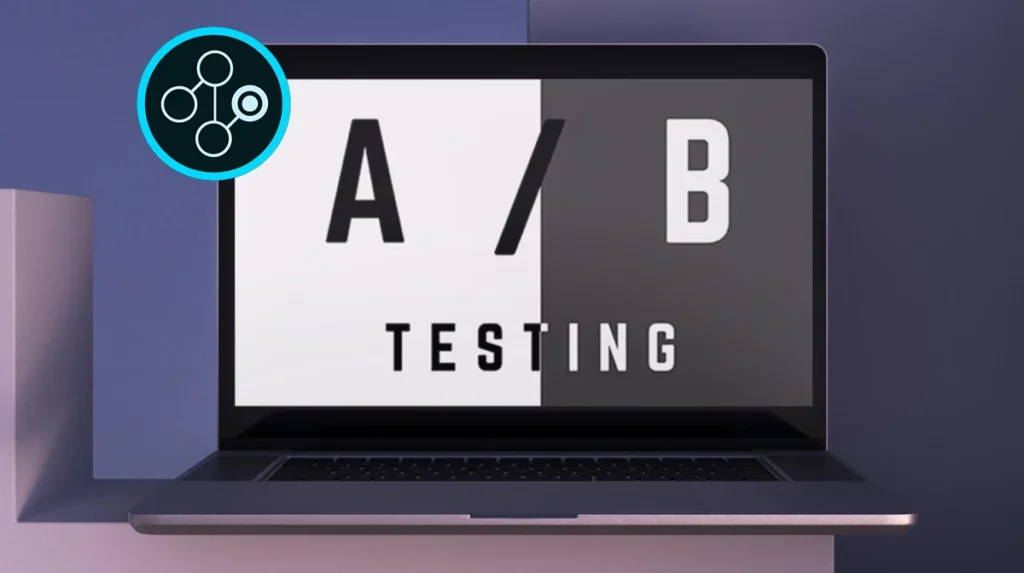In a digital-first world, brands no longer have the luxury to rely on intuition or generic content strategies. The era of personalization is here, and users expect every click, scroll, and swipe to be tailored just for them. While A/B testing has been the cornerstone of optimization, it is only the tip of the iceberg. Welcome to the world beyond A/B testing—a landscape shaped by advanced experimentation, machine learning, and deep personalization.
Adobe Target is at the forefront of this evolution. This powerful tool enables marketers, product managers, and digital teams to conduct robust testing, derive real-time insights, and deliver experiences that resonate on an individual level. This article delves into the advanced experimentation techniques enabled by Adobe Target Services, breaking down how to leverage them for effective optimization.
1. The Limitations of A/B Testing
1.1 What is A/B Testing?
A/B testing involves comparing two versions of a web page or app to determine which one performs better. It’s simple, measurable, and a great way to validate hypotheses.
1.2 Where A/B Testing Falls Short
- Limited Scope: You can only test two variants at a time.
- Time-Consuming: Running multiple A/B tests sequentially requires a significant amount of time.
- Oversimplification: Human behavior isn’t binary.
- Ignores Personalization: One-size-fits-all decisions can alienate segments of your audience.
To achieve true optimization, you need strategies that embrace complexity, scale with your audience, and respond dynamically.
2. Enter Adobe Target: A Suite for Advanced Optimization
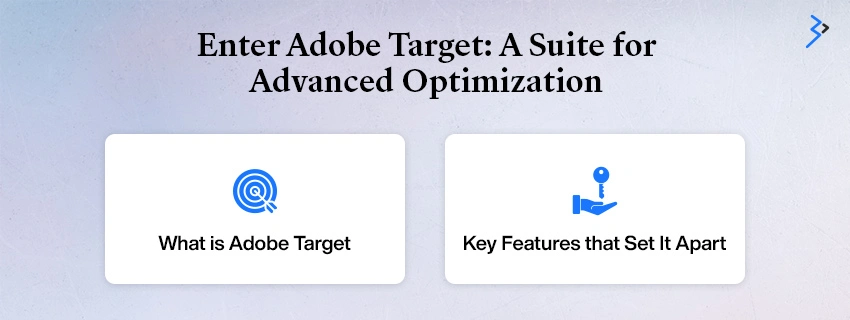
Ready to supercharge your digital experience? Meet Adobe Target, your AI-powered partner in delivering personalization that clicks—literally.
2.1 What is Adobe Target?
A dynamic tool in the Adobe Commerce Cloud Services, Adobe Target helps you test, tailor, and transform digital journeys in real-time.
2.2 Key Features that Set It Apart:
- A/B & Multivariate Testing (MVT): Run smart experiments to discover what works best.
- Automated Personalization (AP): Serve dynamic content to each user based on behavior.
- Recommendations Engine: Suggest products/content like a pro.
- Auto-Target: Leverage AI to personalize for different audience segments.
- Powered by Adobe Sensei: Gain actionable insights with machine learning.

Adobe Target doesn’t just show you what worked—it reveals why it worked and who it worked for. Personalization just got smarter.
Read More – The Composable DXP Advantage: Building Agile Digital Experiences with Adobe Solutions
3. Multivariate Testing: Unpacking the Combinations
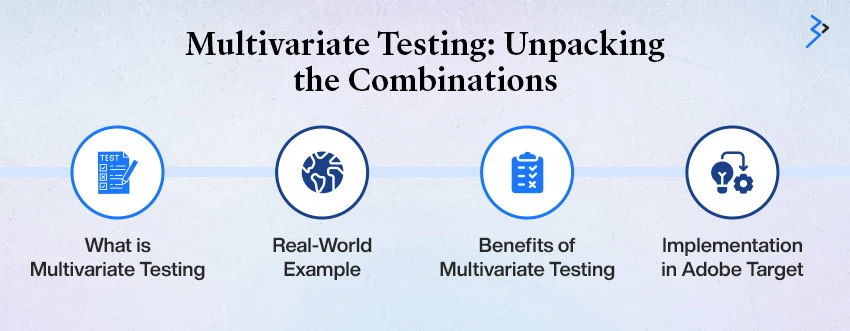
When it comes to optimizing digital experiences, it’s not just about testing one change at a time. Sometimes, the real magic lies in understanding how multiple elements work together. That’s where Multivariate Testing (MVT) comes into play. Adobe Target makes this sophisticated form of testing not only possible, but seamless.
3.1 What is Multivariate Testing?
Unlike traditional A/B testing, which compares two distinct versions of a page or experience, multivariate testing dives deeper. It analyzes how multiple elements—like headlines, images, buttons, and layouts—interact with each other. Rather than changing one thing at a time, MVT tests all possible combinations of selected elements simultaneously. This allows marketers and UX teams to pinpoint not just what works, but why it works, by examining how individual components impact overall performance when paired together.
3.2 Real-World Example
Let’s take a simple landing page scenario. Imagine this page has:
- 3 different headlines
- 2 call-to-action (CTA) buttons
- 2 background images
With multivariate testing, instead of running 12 separate A/B tests (one for each combination), you can launch a single MVT experiment that tests all 3 x 2 x 2 = 12 combinations at once. Adobe Target tracks user interactions and analyzes performance to find which combination of headline, CTA, and image yields the best results, whether that means more clicks, higher conversions, or longer time spent on page.
This approach provides a clear view of how each individual element contributes to success when used in tandem with others, revealing powerful synergy or conflicts—you may never have noticed otherwise.
3.3 Benefits of Multivariate Testing
Implementing MVT brings several advantages to digital marketers and optimization teams:
- Deeper insights: You don’t just learn which version is better—you understand why it performs better. You uncover which individual elements drive engagement and which combinations truly resonate.
- Faster learning: Since multiple elements are tested in one go, you gather insights faster than sequential A/B testing.
- Efficient use of traffic: Instead of dividing users across many separate tests, MVT allows you to optimize traffic distribution and make the most out of existing site visitors. This is especially valuable when traffic is limited or you’re working with niche segments.
3.4 Implementation in Adobe Target
Running a multivariate test can sound complex, but Adobe Target makes it remarkably intuitive. With its visual editing tools, you can quickly set up experiments without writing code. The interface allows you to select which page elements to test and enter your variations.
Behind the scenes, Adobe Target uses advanced statistical models to ensure that results are both accurate and meaningful. It handles complex calculations, distributes traffic intelligently, and provides real-time reporting on how each element and its combinations perform.
Additionally, Adobe Target leverages Adobe Sensei, its AI engine, to help interpret results and suggest the best-performing configurations. This enables you to transition from insight to action without getting bogged down in data analysis.
In summary, multivariate testing with Adobe Target empowers teams to uncover high-impact combinations, streamline experimentation, and deliver better digital experiences—faster and smarter.
Read More – Scaling Your eCommerce Business Effectively with Adobe Commerce on AACS
4. Auto-Target and Automated Personalization: AI at Work
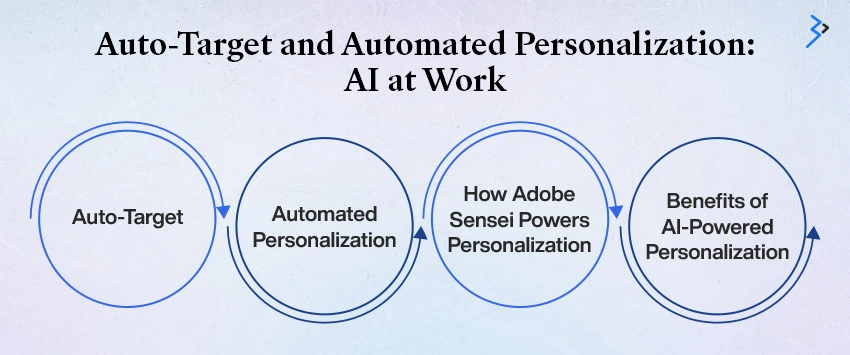
4.1 Auto-Target
Auto-Target uses machine learning development to personalize experiences based on visitor behavior. Instead of showing everyone the same winning variant, it delivers the version most likely to engage each visitor.
4.2 Automated Personalization (AP)
AP takes things further by identifying the best combination of content for each visitor in real time.
4.3 How Adobe Sensei Powers Personalization
Adobe Sensei, Adobe’s AI and machine learning framework, underpins Auto-Target and AP. It analyzes vast data sets to:
- Segment audiences dynamically
- Predict behavior
- Optimize in real time
4.4 Benefits of AI-Powered Personalization
- Increased engagement
- Higher conversion rates
- Real-time optimization
- Continuous learning from new data
5. Recommendations Engine: Hyper-Personalized Content Delivery

In the age of personalization, generic experiences just don’t cut it anymore. Today’s users expect content, products, or services tailored specifically to their needs and preferences. That’s where a recommendations engine becomes a game-changer—and Adobe Target brings this capability to life with precision and power.
5.1 What is a Recommendations Engine?
A recommendations engine is a system designed to deliver personalized suggestions to users based on their behavior, preferences, and contextual information. Whether it’s recommending a product in an online store, surfacing related content on a blog, or suggesting services a user might find valuable, the engine works by analyzing patterns and making intelligent predictions.
At its core, it answers the question: What is this user most likely to engage with next? And it does so in real-time, ensuring that each user journey feels personal and relevant.
5.2 Adobe Target’s Recommendation Capabilities
Adobe Target enhances traditional recommendation models with a suite of advanced capabilities that blend data, rules, and AI:
- Algorithm-Based Suggestions: Adobe Target uses machine learning algorithms to track and analyze user interactions across channels. These include popular recommendation logics such as “most viewed,” “people also bought,” and “recently viewed,” among others.
- Rule-Based Customization: While algorithms offer automation, Adobe Target also allows marketers to define rules, ensuring that business objectives, inventory limitations, or compliance needs are met alongside personalization efforts.
- Contextual Relevance: Beyond static behavior, Adobe Target leverages real-time data, including location, device, time of day, and even weather conditions, to refine recommendations and enhance engagement.
These features ensure not only accurate personalization but also strategic alignment with broader marketing goals.
5.3 Use Cases
Recommendation engines are applicable across industries and touchpoints. Some everyday and impactful use cases include:
- E-commerce Product Suggestions: Recommending items based on a customer’s browsing or purchase history to increase conversion and average order value.
- Content Recommendations on Blogs/Media Sites: Suggesting related articles, videos, or topics based on reader behavior and interests to boost engagement time.
- Upsell and Cross-Sell Opportunities: Delivering targeted offers on complementary or premium products right at the moment of purchase intent.
These tailored suggestions create a smoother user experience while quietly driving revenue and retention behind the scenes.
5.4 Building a Recommendation Strategy
To get the most out of Adobe Target’s recommendations engine, you need a thoughtful strategy:
- Define Your Goals: Start with clear objectives. Are you aiming to increase cart size, reduce bounce rate, or improve content engagement?
- Choose the Right Algorithms: Depending on your goal, select the appropriate algorithm, like “trending now” for urgency or “frequently bought together” for boosting basket value.
- Test and Refine Continuously: Use A/B testing and performance analysis to refine your recommendations. Adobe Target offers reporting tools that help identify what’s working and where to make improvements.
By combining smart algorithms with business rules and real-time data, Adobe Target turns passive browsing into guided journeys—delivering exactly what your audience wants before they even ask.
6. Advanced Targeting and Segmentation

6.1 Going Beyond Demographics
Adobe Target allows you to target based on:
- Behavioral data (clicks, purchases)
- Contextual data (location, device, time)
- Psychographics (interests, values)
6.2 Real-Time Targeting
With Adobe Target, you can:
- Adjust experiences on the fly
- Serve location-based offers
- Deliver personalized content streams
6.3 Building Dynamic Audiences
Adobe Target integrates seamlessly with Adobe Audience Manager to build and activate real-time audience segments.
7. Integrations: Supercharging Target with Adobe Ecosystem
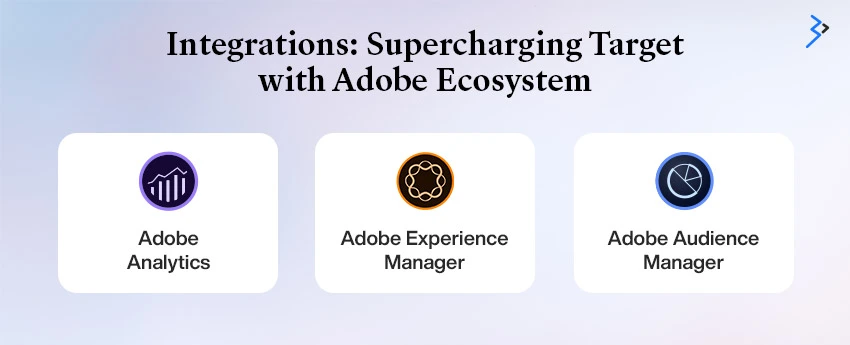
7.1 Adobe Analytics
Link Adobe Target with Analytics to:
- Share audience segments
- Analyze test results in depth
- Attribute results across customer journeys
7.2 Adobe Experience Manager (AEM)
Use AEM and Target together to:
- Personalize content blocks
- Create and test variations seamlessly
7.3 Adobe Audience Manager
Activate high-value audience segments for real-time targeting.
8. Best Practices for Advanced Experimentation
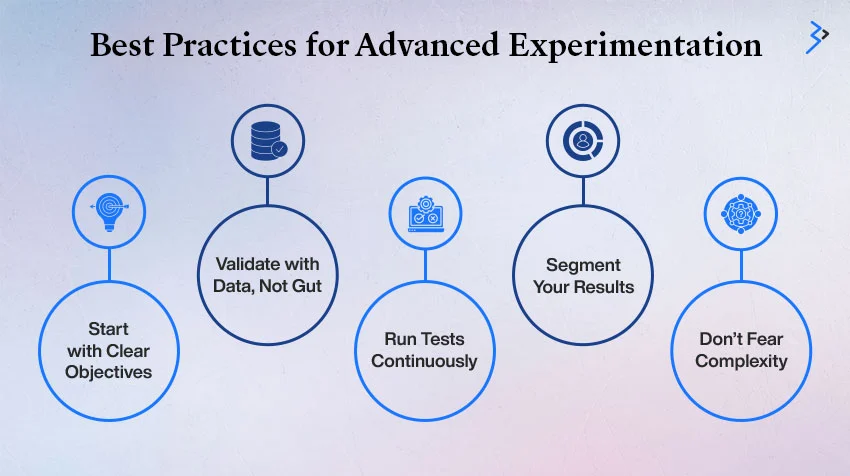
Advanced experimentation is no longer a luxury—it’s a necessity for brands that want to thrive in today’s digital-first landscape. Tools like Adobe Target empower marketers to test, learn, and optimize at scale. But to truly unlock their potential, you need to approach experimentation with strategy and discipline. Here are the key best practices to guide your testing journey.
8.1 Start with Clear Objectives
Every test should begin with a question: What exactly are you testing, and why?
Without a well-defined objective, you risk collecting data without direction.
- Identify the goal—Is it to increase click-through rates, reduce bounce rates, or improve conversion?
- Determine key performance indicators (KPIs) tied to that goal.
- Clarify the user behavior or experience you want to influence.
A clear objective ensures your experiment stays focused and the results are actionable.
8.2 Validate with Data, Not Gut
It’s easy to fall back on intuition or personal preferences. However, in experimentation, data serves as your compass.
- Build hypotheses based on analytics, user behavior insights, or prior test results.
- Utilize historical performance and user journey data to pinpoint areas for improvement or potential opportunities.
- Let the evidence drive your test ideas, not assumptions.
By grounding your approach in data, you reduce bias and increase the likelihood of meaningful outcomes.
8.3 Run Tests Continuously
Optimization is not a one-time project—it’s a continuous cycle.
- Always have a test running, even if it’s small.
- Use iterative testing: once one experiment ends, build on its results in the next.
- Prioritize a test-and-learn culture across teams and departments.
Adobe Target’s tools allow for seamless test deployment, enabling you to build momentum and evolve faster.
8.4 Segment Your Results
A winning experience for one group might fail for another. That’s why segmentation matters.
- Analyze results by user segment: new vs. returning visitors, mobile vs. desktop users, or by geography and demographics.
- Understand how different audience types respond to your variations.
- Personalize based on these insights to unlock deeper engagement and better ROI.
Adobe Target provides built-in segmentation tools to help you uncover hidden patterns in your test results.
8.5 Don’t Fear Complexity
Advanced experimentation often involves multiple variables, audience segments, and personalized content paths. It can seem overwhelming, but it doesn’t have to be.
- Use multivariate testing and auto-personalization to test multiple elements at once.
- Leverage Adobe Target’s AI capabilities, such as Adobe Sensei, to handle complexity at scale.
- Automate repetitive tasks, focus on strategy, and let the platform manage the technical workload.
The key is to strategically embrace complexity, utilizing the right tools to manage it effectively. Complexity, when handled correctly, leads to more precise optimization and better user experiences.
In short, advanced experimentation is both a science and an art. By combining clear goals, data-driven insights, continuous iteration, segmented analysis, and intelligent automation, you set the stage for smarter decisions and stronger outcomes.
Read More – Optimizing the Mobile Experience on Your Adobe Commerce Cloud Store
9. The Future: Adaptive Experiences Powered by AI
We’re moving from personalization to individualization. Adobe Target, powered by Adobe Sensei, is at the forefront of this transformation. The future holds:
- Predictive personalization
- Emotion-aware interfaces
- Voice and gesture-based testing
- Omnichannel experimentation
Conclusion: Time to Go Beyond A/B
The digital experience isn’t a one-size-fits-all world. While A/B testing opened the door to experimentation, tools like Adobe Target have blown the door off its hinges. By embracing advanced testing, machine learning, and deep personalization, brands can create experiences that are not only optimized but unforgettable.
Don’t just test. Transform.
FAQs
While traditional A/B testing tools allow for basic comparison between two versions of content, Adobe Target offers a full suite of advanced features, including multivariate testing, automated personalization, AI-powered Auto-Targeting, and recommendations. It leverages Adobe Sensei to dynamically tailor experiences to individual users, surpassing the capabilities of simple A/B tests.
Auto-Target utilizes machine learning to personalize the version of an experience each user sees, based on their behavioral data. Automated Personalization, on the other hand, identifies the best combination of content elements (such as images, CTAs, and headlines) to serve each user in real-time. Adobe Sensei powers both features, but they differ in scope and execution.
Not necessarily. Adobe Target offers a Visual Experience Composer (VEC) that lets marketers and content creators create and run tests without writing code. However, for more complex implementations or custom experiments, having access to development support can be beneficial.
Absolutely. Adobe Target integrates seamlessly with tools like Adobe Analytics, Adobe Audience Manager, and Adobe Experience Manager. These integrations allow for richer data insights, more precise targeting, and a more cohesive experience management workflow.
The duration depends on your traffic volume and the number of variations being tested. Typically, Adobe Target will indicate when statistical significance is reached. For robust results, it’s best to let the test run for at least 2–4 weeks or until meaningful data is gathered, ensuring seasonality or traffic spikes don’t skew outcomes.
Related Articles
-
Deliver Winning Content at Scale with Adobe GenStudio for Performance Marketing
Marketing departments are under pressure to provide targeted content as budgets compress. Marketers must create compelling, successful campaigns with current and relevant content for all consumers, channels, and platforms. Generative
-
Scaling Your eCommerce Business Effectively with Adobe Commerce on AACS
The digital marketplace is evolving rapidly, making scalability a must for growing eCommerce businesses. Whether meeting rising customer expectations, entering new markets, or managing sudden traffic spikes, companies need a
-
Get to Market Faster and Sell Smarter with Adobe Commerce Cloud
The reality of running an online business in today’s modern world is the endless competition, the dynamic customer needs, and the constant need to be highly nimble. It used to

